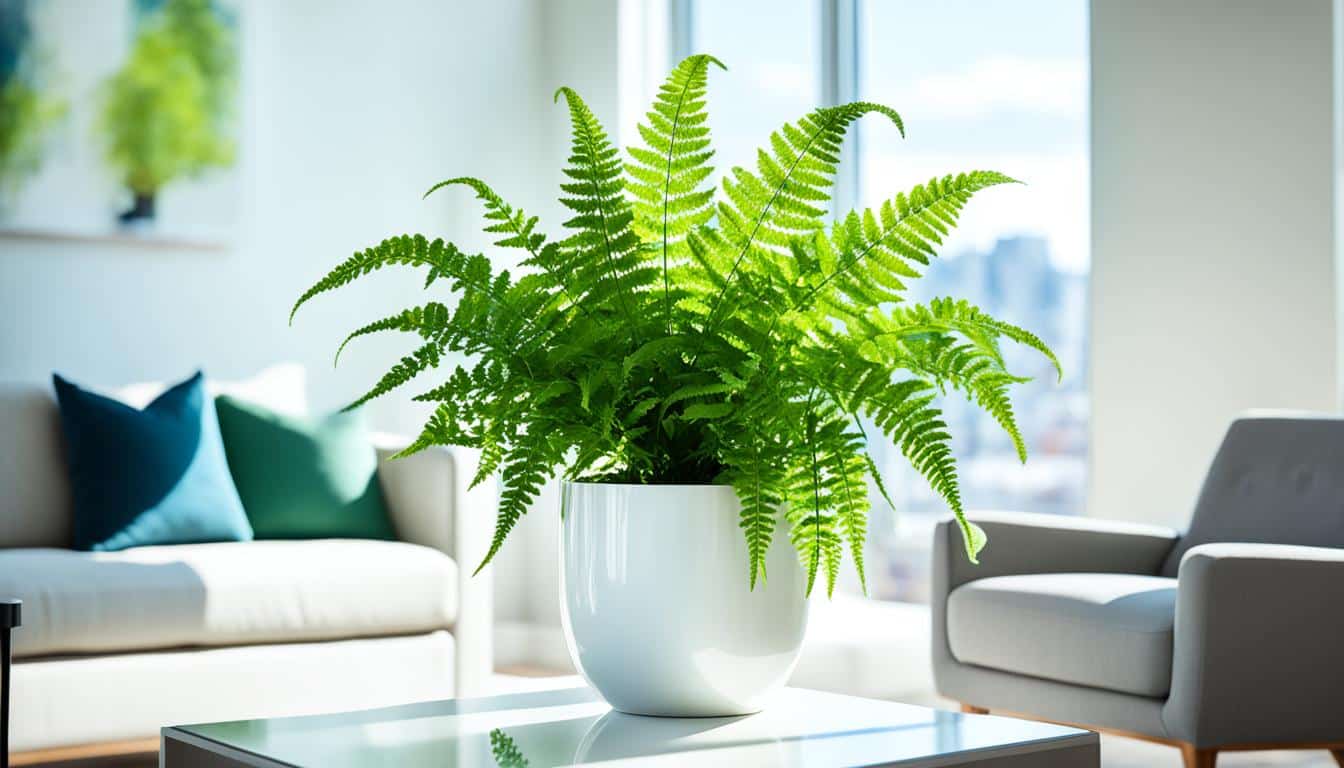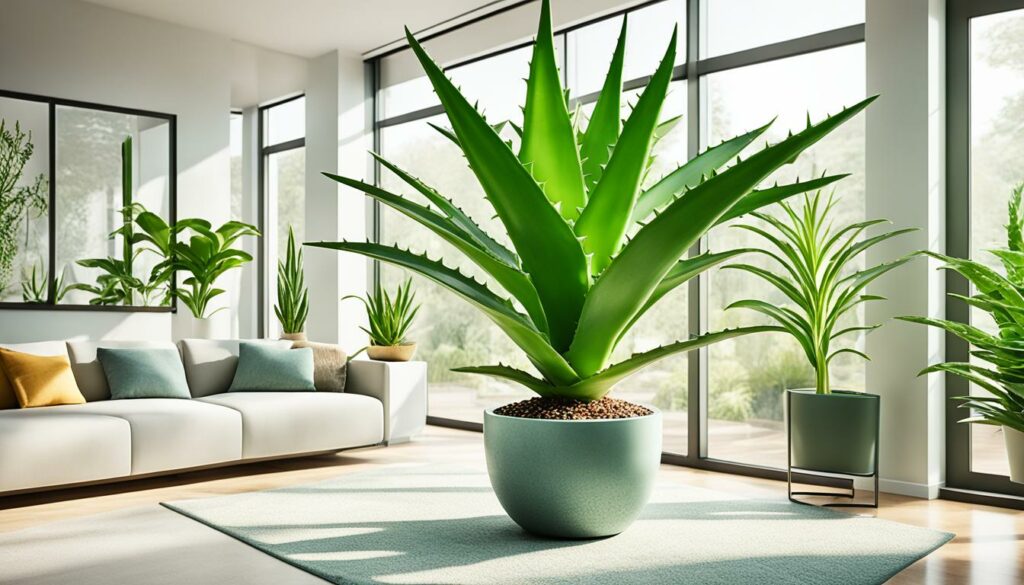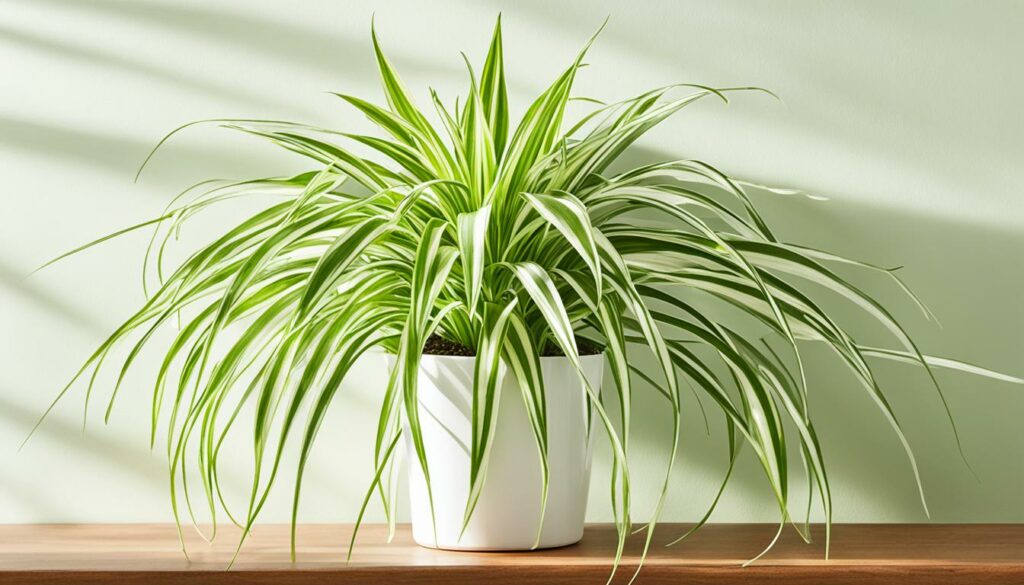
Indoor plants don’t just add beauty to your living space; they also have the incredible ability to improve the air quality by producing oxygen. In this article, we’ll explore the best houseplants for oxygen and how they can enhance the air you breathe indoors. We’ll discuss the importance of indoor air quality and introduce a selection of indoor plants specifically chosen for their oxygen-producing abilities and air-purifying properties.
These plants include the snake plant, aloe vera, spider plant, peace lily, rubber plant, and Boston fern. By incorporating these plants into your home, you can create a green oasis of fresh, oxygen-rich air.
Key Takeaways:
- Indoor plants can significantly improve indoor air quality by producing oxygen.
- The snake plant, aloe vera, spider plant, peace lily, rubber plant, and Boston fern are excellent choices for oxygen production and air purification.
- These plants not only release oxygen but also remove harmful toxins from the air, creating a healthier living environment.
- Incorporating indoor plants into your decor can transform your living space into a lush oxygen haven.
- Enjoy the benefits of a green, oxygen-rich environment by embracing these indoor plants for better air quality.
The Importance of Indoor Air Quality
Indoor air quality is crucial for our health and well-being, especially since many of us spend a significant amount of time indoors. Poor indoor air quality can lead to various health problems, including respiratory issues and allergies.
By creating an environment that promotes fresh, oxygen-rich air, we can improve our overall well-being. Indoor plants play a vital role in this process by absorbing carbon dioxide and releasing oxygen through photosynthesis. They act as natural air purifiers, filtering out toxins and enhancing the air we breathe.
“Indoor plants play a vital role in this process by absorbing carbon dioxide and releasing oxygen through photosynthesis.”
By introducing indoor plants into our living spaces, we can enjoy the benefits of cleaner, healthier air. These plants not only improve indoor air quality but also add natural beauty to our homes. With their oxygen-producing abilities, they create a refreshing atmosphere that promotes wellness and vitality.
Benefits of Indoor Plants for Air Quality:
- Enhances the supply of fresh, oxygen-rich air
- Reduces levels of carbon dioxide and other pollutants
- Filters out toxins and improves overall air quality
- Creates a more pleasant and enjoyable living environment
How Indoor Plants Improve Indoor Air Quality:
- Oxygen Production: Indoor plants release oxygen into the air through the process of photosynthesis, increasing the oxygen levels in our living spaces.
- Absorption of Carbon Dioxide: Plants absorb carbon dioxide, a common indoor pollutant, and convert it into oxygen, effectively reducing its concentration in the air.
- Air Purification: Indoor plants have the ability to remove toxins and pollutants from the air, improving overall air quality and reducing the risk of respiratory issues.
By incorporating indoor plants into our homes and workplaces, we can create a healthier and more vibrant environment. These green companions not only enhance the aesthetics of our spaces but also contribute to our physical and mental well-being.
Creating a sustainable indoor oasis with a variety of oxygen-producing plants is a simple yet effective way to improve our indoor air quality and experience the benefits of fresh, oxygen-rich air.
Snake Plant (Sansevieria trifasciata)
The snake plant, also known as the mother-in-law’s tongue, is an excellent choice for oxygen production. It is one of the easiest plants to care for and can thrive in various lighting conditions. Snake plants are particularly efficient at converting carbon dioxide into oxygen, making them perfect additions to bedrooms and living areas. They also have air-purifying properties, removing toxins from the air and improving indoor air quality.
If you’re looking for a low-maintenance houseplant that offers both aesthetic appeal and health benefits, the snake plant is an ideal option. Its upright, sword-shaped leaves create a striking visual contrast against other indoor plants, making it a popular choice for interior decorators.
One of the greatest advantages of the snake plant is its adaptability to various lighting conditions. Whether your home has bright, indirect light or low light, this resilient plant can thrive and continue producing oxygen. It’s a versatile choice for different rooms and spaces within your home.
Benefits of Snake Plants:
- Efficient oxygen production
- Air-purifying properties
- Easy care requirements
- Tolerant of different lighting conditions
Snake plants are known for their ability to absorb harmful toxins from the air, such as formaldehyde and benzene, contributing to a healthier indoor environment. The oxygen they release can help improve air quality, making them particularly beneficial for individuals with respiratory issues or allergies.
“The snake plant is not only aesthetically pleasing but also a powerhouse when it comes to oxygen production. Its easy care requirements and adaptability to different lighting conditions make it a top choice for bringing freshness and purity into your home.” – Sarah Matthews, Indoor Gardening Expert
| Snake Plant Care Tips | Lighting | Watering | Temperature |
|---|---|---|---|
| Place in bright, indirect light for optimal growth. | Allow the soil to dry between waterings. | Snake plants can tolerate temperature ranges between 55°F and 85°F (13°C and 29°C). | |
| Avoid direct sunlight as it can scorch the leaves. | Water sparingly as snake plants prefer slightly dry conditions. | Avoid exposing the plant to cold drafts or extreme temperatures. |
By including a snake plant in your indoor plant collection, you can create a harmonious environment that enhances air quality and adds a touch of natural beauty to your living space.
Aloe Vera (Aloe barbadensis miller)
Aloe vera is not only known for its soothing gel but also its ability to release oxygen at night. This unique characteristic can help improve sleep quality by providing a fresh oxygen supply in your bedroom. Aloe vera plants prefer low light conditions, making them suitable for various indoor settings. They are low-maintenance plants that require minimal watering and can thrive in indirect light.
With its vibrant green color and unique gel-filled leaves, aloe vera is a visually appealing addition to any indoor space. Its ability to release oxygen during the night makes it an ideal bedroom plant, creating a calming and oxygen-rich environment that promotes restful sleep.
“Aloe vera’s oxygen-releasing properties can improve sleep quality, allowing you to wake up feeling rejuvenated and well-rested.”
Aloe vera plants are well-suited for low light conditions, making them versatile and adaptable to different rooms and light levels. Whether placed on your bedside table, office desk, or living room shelf, the aloe vera plant will thrive and continue to release oxygen, purifying the air and enhancing the overall environment.
Benefits of Aloe Vera for Sleep Quality:
- Aloe vera releases oxygen at night, improving sleep quality
- Creates a soothing and oxygen-rich environment in the bedroom
- Helps to reduce stress and promote relaxation
To incorporate aloe vera into your indoor space, place it near a window with indirect sunlight or use artificial lighting in low light conditions. Remember to water the plant sparingly, as overwatering can lead to root rot.

With its oxygen-releasing properties and soothing gel, aloe vera is not only an excellent addition to your indoor plant collection but also a natural remedy for improving sleep quality. Embrace the benefits of aloe vera and create a serene oasis in your home, where you can breathe deeply and enjoy the tranquility of nature.
Spider Plant (Chlorophytum comosum)
The spider plant, scientifically known as Chlorophytum comosum, is a popular choice for indoor gardening enthusiasts. Not only does it add a touch of greenery to your space, but it also boasts remarkable air-purifying properties and oxygen production.
One of the greatest advantages of spider plants is their easy care. They are perfect for beginners or anyone with a busy lifestyle. Spider plants can thrive in various lighting conditions, including low light, making them a versatile choice for any room.
With their long, arching leaves and attractive white and green stripes, spider plants also serve as decorative elements. Whether placed in a hanging basket or potted on a shelf, these plants add visual interest to any space.
When it comes to improving indoor air quality, spider plants are highly effective. They are known for their ability to eliminate airborne pollutants such as carbon monoxide and xylene, creating a healthier and fresher environment. By introducing a spider plant into your home, you can breathe in cleaner, oxygen-rich air.

| Benefits of Spider Plants | Care Tips |
|---|---|
| – Air-purifying properties | – Place in bright, indirect light |
| – Oxygen production | – Water thoroughly, allowing the soil to dry between waterings |
| – Easy care | – Can tolerate low light conditions |
| – Suitable for various lighting conditions | – Fertilize monthly during the growing season |
Conclusion
Enhancing indoor air quality and creating a green, oxygen-rich environment is easily achievable through the use of indoor plants. The snake plant, aloe vera, spider plant, peace lily, rubber plant, and Boston fern are excellent choices for improving air quality and increasing oxygen levels in your home. These plants not only release oxygen, but they also have the added benefit of purifying the air by removing harmful toxins.
By incorporating these indoor plants into your decor, you can transform your living space into a lush oxygen haven. Not only will you experience the physical benefits of improved air quality, but you’ll also create a vibrant and inviting atmosphere. These plants require minimal maintenance and can thrive in various lighting conditions, making them suitable for any indoor setting.
Embracing a green living lifestyle by introducing oxygen-producing houseplants into your home not only benefits your health but also contributes to a sustainable environment. By reducing the use of artificial air fresheners and improving indoor air quality naturally, you’ll be taking a step towards creating a healthier and more eco-friendly living space.
So why wait? With the snake plant, aloe vera, spider plant, peace lily, rubber plant, and Boston fern, you can breathe easy and live well in an oxygen-rich environment. Enhance your indoor air quality, embrace green living, and enjoy the countless benefits these indoor plants have to offer.
FAQ
What are the best indoor plants for oxygen?
The best indoor plants for oxygen production and air quality include the snake plant, aloe vera, spider plant, peace lily, rubber plant, and Boston fern.
Do indoor plants really produce oxygen?
Yes, indoor plants produce oxygen through photosynthesis by absorbing carbon dioxide from the air and releasing oxygen.
How do indoor plants improve air quality?
Indoor plants act as natural air purifiers by filtering out toxins and pollutants from the air, resulting in improved indoor air quality.
Can indoor plants improve sleep quality?
Yes, some indoor plants like aloe vera release oxygen at night, which can help improve sleep quality by providing a fresh oxygen supply in the bedroom.
Are these indoor plants low-maintenance?
Yes, most of the recommended indoor plants for oxygen are low-maintenance and can thrive in various lighting conditions with minimal care.
Can I place these plants in any room?
Yes, these indoor plants can be placed in different rooms based on their lighting and care requirements. However, they are particularly beneficial in bedrooms and living areas where we spend a significant amount of time.
How do these indoor plants remove toxins from the air?
These indoor plants have natural air-purifying properties, absorbing toxins like carbon monoxide and xylene through their leaves and soil, effectively filtering the air and improving overall indoor air quality.
Will these indoor plants require a lot of watering?
No, most of these indoor plants have low water requirements and can tolerate periods of dry soil. They are ideal choices for individuals with busy lifestyles or those who tend to forget watering plants frequently.
Can I grow these plants in low light conditions?
Yes, many of the recommended indoor plants for oxygen, such as snake plants, aloe vera, and spider plants, can thrive in low light conditions. They are adaptable and can still produce oxygen and contribute to better air quality even with less natural light.
Do these plants have any other benefits besides oxygen production?
Yes, besides producing oxygen, these indoor plants also have additional benefits like improving humidity levels, reducing stress, and enhancing overall well-being.
